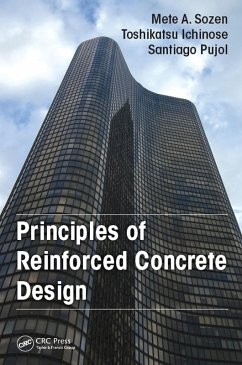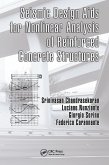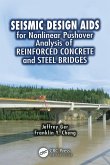Principles of Reinforced Concrete Design (eBook, PDF)


Alle Infos zum eBook verschenken

Principles of Reinforced Concrete Design (eBook, PDF)
- Format: PDF
- Merkliste
- Auf die Merkliste
- Bewerten Bewerten
- Teilen
- Produkt teilen
- Produkterinnerung
- Produkterinnerung

Hier können Sie sich einloggen

Bitte loggen Sie sich zunächst in Ihr Kundenkonto ein oder registrieren Sie sich bei bücher.de, um das eBook-Abo tolino select nutzen zu können.
The book covers fundamental concepts related to mechanics and direct observation, and those required to design reinforced concrete (RC) structures. Codes change over time depending on factors that have little to do with the fundamental concepts mentioned, and have more to do with the markets, construction practices, and transient academic views. For beginning engineers it is difficult to distinguish between rules based on consensus (codes) and fundamentals. This book focuses on the latter to prepare use and adaptation to the constant changes of the former.
- Geräte: PC
- ohne Kopierschutz
- eBook Hilfe
- Größe: 11.6MB
![Design Examples for High Strength Steel Reinforced Concrete Columns (eBook, PDF) Design Examples for High Strength Steel Reinforced Concrete Columns (eBook, PDF)]() Sing-Ping ChiewDesign Examples for High Strength Steel Reinforced Concrete Columns (eBook, PDF)16,95 €
Sing-Ping ChiewDesign Examples for High Strength Steel Reinforced Concrete Columns (eBook, PDF)16,95 €![Design of High Strength Steel Reinforced Concrete Columns (eBook, PDF) Design of High Strength Steel Reinforced Concrete Columns (eBook, PDF)]() Sing-Ping ChiewDesign of High Strength Steel Reinforced Concrete Columns (eBook, PDF)16,95 €
Sing-Ping ChiewDesign of High Strength Steel Reinforced Concrete Columns (eBook, PDF)16,95 €![Tall Building Foundation Design (eBook, PDF) Tall Building Foundation Design (eBook, PDF)]() Harry G. PoulosTall Building Foundation Design (eBook, PDF)60,95 €
Harry G. PoulosTall Building Foundation Design (eBook, PDF)60,95 €![Seismic Design Aids for Nonlinear Analysis of Reinforced Concrete Structures (eBook, PDF) Seismic Design Aids for Nonlinear Analysis of Reinforced Concrete Structures (eBook, PDF)]() Srinivasan ChandrasekaranSeismic Design Aids for Nonlinear Analysis of Reinforced Concrete Structures (eBook, PDF)51,95 €
Srinivasan ChandrasekaranSeismic Design Aids for Nonlinear Analysis of Reinforced Concrete Structures (eBook, PDF)51,95 €![Reinforced Concrete Design to Eurocodes (eBook, PDF) Reinforced Concrete Design to Eurocodes (eBook, PDF)]() Prab BhattReinforced Concrete Design to Eurocodes (eBook, PDF)66,95 €
Prab BhattReinforced Concrete Design to Eurocodes (eBook, PDF)66,95 €![FRP Composites for Reinforced and Prestressed Concrete Structures (eBook, PDF) FRP Composites for Reinforced and Prestressed Concrete Structures (eBook, PDF)]() Perumalsamy BalaguruFRP Composites for Reinforced and Prestressed Concrete Structures (eBook, PDF)60,95 €
Perumalsamy BalaguruFRP Composites for Reinforced and Prestressed Concrete Structures (eBook, PDF)60,95 €![Seismic Design Aids for Nonlinear Pushover Analysis of Reinforced Concrete and Steel Bridges (eBook, PDF) Seismic Design Aids for Nonlinear Pushover Analysis of Reinforced Concrete and Steel Bridges (eBook, PDF)]() Jeffrey GerSeismic Design Aids for Nonlinear Pushover Analysis of Reinforced Concrete and Steel Bridges (eBook, PDF)73,95 €
Jeffrey GerSeismic Design Aids for Nonlinear Pushover Analysis of Reinforced Concrete and Steel Bridges (eBook, PDF)73,95 €-
-
-
Dieser Download kann aus rechtlichen Gründen nur mit Rechnungsadresse in A, B, BG, CY, CZ, D, DK, EW, E, FIN, F, GR, HR, H, IRL, I, LT, L, LR, M, NL, PL, P, R, S, SLO, SK ausgeliefert werden.
- Produktdetails
- Verlag: Taylor & Francis
- Seitenzahl: 295
- Erscheinungstermin: 14. Juli 2014
- Englisch
- ISBN-13: 9781482231496
- Artikelnr.: 57082667
- Verlag: Taylor & Francis
- Seitenzahl: 295
- Erscheinungstermin: 14. Juli 2014
- Englisch
- ISBN-13: 9781482231496
- Artikelnr.: 57082667
Toshikatsu Ichinose completed his undergraduate education in architectural engineering at Nagoya Institute of Technology and earned graduate degrees at the University of Tokyo. In 1982, he returned to Nagoya Institute of Technology, where he now teaches structural mechanics and reinforced concrete. Dr. Ichinose has been chairing the committee in charge of RC building code of the Architectural Institute of Japan since 2004. He is proud to be a coauthor of Understanding Structures (CRC Press, 2008).
Santiago Pujol is from Medellín, Colombia, where he was first exposed to the reinforced concrete industry by his father, an architect who designed and directed the construction of a number of residential and commercial buildings in the city. He completed his undergraduate education in civil engineering at the School of Mines at the National University of Colombia in 1996. At the time, the School of Mines had a five-year undergraduate program designed after European academic models. Damage caused by earthquakes in Colombia motivated him to earn an MS and PhD from Purdue University, West Lafayette, Indiana. Dr. Pujol worked with a forensic firm in San Francisco, California, from 2002 to 2005. During that time, he traveled to Japan and started lasting collaborations with Japanese engineers whose wisdom and attention to proportions and aesthetics have a strong influence on his views. In 2005, he returned to Purdue University, where he currently teaches reinforced concrete and experimental methods and conducts research dealing with the effects of blasts and earthquakes on buildings, and basic questions on the mechanics of concrete structures.
Concrete. The Design Process. Properties of Steel Reinforcement. Concrete.
Time-Dependent Volume Changes of Concrete: Shrinkage and Creep. Tied
Columns. Axial Strength of Laterally Confined Concrete. Spiral Columns.
Measures of Flexural Response. A General Description of Flexural Response.
Moment-Curvature Relationship before Flexural Cracking. Linear Response of
Cracked Sections. Limiting Moment and Unit Curvature. Development of a
Quantitative Relationship between Moment and Unit Curvature. Maximum and
Minimum Amounts of Longitudinal Reinforcement for Beams. Beams with
Compression Reinforcement. Beams with Flanges. Deflection under Short-Time
Loading. Effects of Time-Dependent Variables on Deflection. Continuous
Beam. Limiting Load. Combinations of Limiting Axial Force and Bending
Moment for a Reinforced Concrete Section. Bond Properties of Plain Bars in
Concrete. Bond between Deformed Bars and Concrete. Factors That Affect
Bond. Design Examples for Bond. Control of Flexural Cracks. Combined
Bending and Shear. Transverse Reinforcement. Index.
Concrete. The Design Process. Properties of Steel Reinforcement. Concrete.
Time-Dependent Volume Changes of Concrete: Shrinkage and Creep. Tied
Columns. Axial Strength of Laterally Confined Concrete. Spiral Columns.
Measures of Flexural Response. A General Description of Flexural Response.
Moment-Curvature Relationship before Flexural Cracking. Linear Response of
Cracked Sections. Limiting Moment and Unit Curvature. Development of a
Quantitative Relationship between Moment and Unit Curvature. Maximum and
Minimum Amounts of Longitudinal Reinforcement for Beams. Beams with
Compression Reinforcement. Beams with Flanges. Deflection under Short-Time
Loading. Effects of Time-Dependent Variables on Deflection. Continuous
Beam. Limiting Load. Combinations of Limiting Axial Force and Bending
Moment for a Reinforced Concrete Section. Bond Properties of Plain Bars in
Concrete. Bond between Deformed Bars and Concrete. Factors That Affect
Bond. Design Examples for Bond. Control of Flexural Cracks. Combined
Bending and Shear. Transverse Reinforcement. Index.







